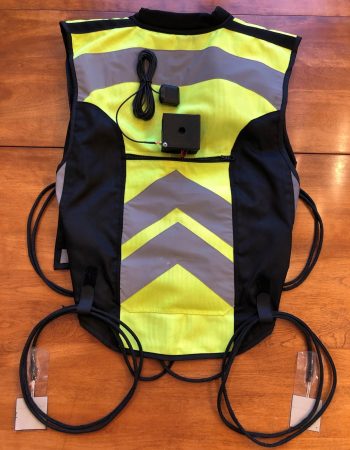OUR PRODUCT
PRODUCT OVERVIEW
The DDC system is a wearable device, incorporated into a vest that is worn on the outside of your racing leathers. It’s powered by a small battery and incorporates a GPS unit plus data acquisition in a small, lightweight module that can fit in the palm of your hand.


Sensors that detect the amount of force the rider applies to hands and feet are connected to the data acquisition unit. Once a rider is ‘wired up’, the system records the rider’s movements, including magnitude of inputs, rate of force application, moments of minimum force, and speed. The GPS data allows DDC coaches to determine exactly what the rider is doing at any given point on the track.

What To Expect With Data Driven Coaching
The typical day with Data Driven Coaching goes something like this:
Your coach will meet you to help get you ‘wired up’, as you are getting into your leathers before a session.
The sensors get applied directly to your hands (they will fit comfortably under your gloves), and also to the bottoms of your feet (outside your socks).
Your coach will switch on the data acquisition unit before you roll out for your session.
You’ll then ride a session as you normally do.
When you get back to the garage, your coach will turn off the data acquisition unit and help you remove the vest and sensors.
Your coach will download the data from your session and examine the results with you.
You’ll be asked about the session and any trouble spots you were having. You’ll look at the data together and receive recommendations based on what the data shows you were applying for forces to the motorcycle during those moments.
You’ll then know exactly what to work on. Your coach can give you technique drills to help you overcome the physical or mental barriers that are holding you back. You can then work on these skills in subsequent sessions.
Together with your coach you can decide if you’d like to record data from additional sessions to confirm your changes. Or, work on your new skills independently and look for the proof of improvement in your lap times!
The Data Driven Coaching system will capture the data you need to identify bad habits that are keeping you from your maximum performance!
EXAMPLES
#1
- New Hampshire Motor Speedway
- Kawasaki Ninja 400
- Novice
Situation
Rider has sensation of nearing limit of traction in turns 3 and 9. Fears “losing the front” if attempting to carry more speed through those corners.
RESULTS
The data showed that in both turns 3 and 9 this rider had significant pressure on his hands, especially the inside hand. Furthermore, in turn 3 the rider was not transferring his weight to the inside foot, as is evident by the low force values on his feet.
CONCLUSION
The data showed that the rider needed to use his core and legs to achieve a mid-corner body position that allowed him to release pressure from his hands. Additionally, when pressure is released from the hands as lean angle increases, it should simultaneously transfer to the foot towards the inside of the corner. By focusing on technique in these two corners, this rider set a PR lap time in the very next session!
Watch the video to see part of the EXAMPLE!
#2
- New York Safety Track
- Suzuki SV650
- Expert
Situation
Rider consistently runs wide through high speed “S” section, misses apexes and must scrub speed to compensate.
RESULTS
Data indicates that the rider does not apply significant bar pressure at turn-in point. Instead, applies pressure to footpegs in attempt to help motorcycle to turn.
CONCLUSION
Rider needs to apply significant and precise hand pressure to initiate turn in. Once at lean, rider has good body position to release hand pressure. However, missed apexes and running wide in corners is due to late (or minimal) bar pressure applied at initiation of turn.
Watch the video to see part of the EXAMPLE!
#3
- New Hampshire Motor Speedway
- Suzuki GSXR 600
- Pro
Situation
Rider A has difficulty with bike setup. Complains of left knee pain when turning left. Also indicates right leg fatigue near the end of longer sessions.
RESULTS
The data showed consistent application of correct technique in right turns. Maximum pressure on the right foot, and minimum pressure on both hands. Thus providing maximum weight transfer towards the inside of the corner, forcing the bike to turn right.
Comparatively, the data showed that during left turns this rider was unable to apply maximum force to left foot. To compensate, the rider applied more force to outside (right) foot for leverage to drive right knee against the bike, thus allowing more weight transfer towards the inside of the corner thus helping the bike to turn left. This extra effort with the right leg explains the right leg fatigue during long sessions.
CONCLUSION
By lowering the rearsets, this rider was able to achieve a riding position with a more open knee angle. This allowed maximum load to be applied to the left foot during left turns, without any knee pain. This also reduced the need to compensate with the right leg, and dramatically reduced fatigue.
Watch the video to see part of the EXAMPLE!
